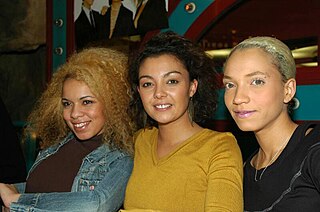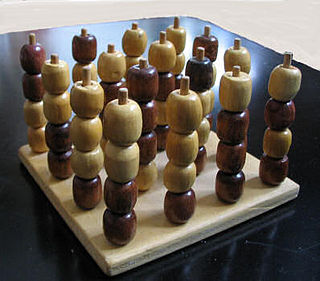
Tic-tac-toe, noughts and crosses, or Xs and Os is a paper-and-pencil game for two players, X and O, who take turns marking the spaces in a 3×3 grid. The player who succeeds in placing three of their marks in a horizontal, vertical, or diagonal row is the winner.

3D tic-tac-toe, also known by the trade name Qubic, is an abstract strategy board game, generally for two players. It is similar in concept to traditional tic-tac-toe but is played in a cubical array of cells, usually 4x4x4. Players take turns placing their markers in blank cells in the array. The first player to achieve four of their own markers in a row wins. The winning row can be horizontal, vertical, or diagonal on a single board as in regular tic-tac-toe, or vertically in a column, or a diagonal line through four boards.

Tic Tac Toe was an all-female German group formed in 1995, performing pop-rap music. Their first two albums, Tic Tac Toe and Klappe die 2te, were million-selling commercial successes and spawned major hits "Ich find' dich scheiße", "Verpiss' dich" and "Warum?". The band found biggest popularity in German speaking countries, the Netherlands and Eastern Europe. Due to numerous scandals and personal issues between the group members, Tic Tac Toe split in 2000. The band had a successful but short-lived comeback in 2005 with the hit single "Spiegel", but ultimately disbanded in 2007.

Toss Across is a game first introduced in 1969 by the now defunct Ideal Toy Company. The game was designed by Marvin Glass and Associates and created by Hank Kramer, Larry Reiner and Walter Moe, and is now distributed by Mattel. It is a game in which participants play tic-tac-toe by lobbing small beanbags at targets in an attempt to change the targets to their desired letter. As in traditional tic-tac-toe, the first player to get three of their letters in a row wins the game. There are other similar games to Toss Across known under different names, such as Tic Tac Throw.

The Pentagon Spy by Franklin W. Dixon is the 61st title of the Hardy Boys Mystery Stories. It was published by Wanderer Books in 1980 and by Grosset & Dunlap in 2005.

Quantum tic-tac-toe is a "quantum generalization" of tic-tac-toe in which the players' moves are "superpositions" of plays in the classical game. The game was invented by Allan Goff of Novatia Labs, who describes it as "a way of introducing quantum physics without mathematics", and offering "a conceptual foundation for understanding the meaning of quantum mechanics".

Score Four is a 3-D version of the abstract strategy game Connect Four. It was first sold under the name "Score Four" by Funtastic in 1968. Lakeside issued 4 different versions in the 1970s. Later Hasbro sold the game as "Connect Four Advanced" in the UK.
Harary's generalized tic-tac-toe or animal tic-tac-toe is a generalization of the game tic-tac-toe, defining the game as a race to complete a particular polyomino on a square grid of varying size, rather than being limited to "in a row" constructions. It was devised by Frank Harary in March 1977, and is a broader definition than that of an m,n,k-game.
Carol Shaw was one of the first female game designers and programmers in the video game industry. She is best known for creating the Atari 2600 vertically scrolling shooter River Raid (1982) for Activision. She worked for Atari, Inc. from 1978-1980 where she designed multiple games including 3-D Tic-Tac-Toe (1978) and Video Checkers (1980), both for the Atari 2600. She left game development in 1984 and retired in 1990.
Warehouse Rumble is a Hardy Boys mystery novel in the Digest series, credited to the pseudonymous Franklin W. Dixon and published in 2004.

Zillions of Games is a commercial general game playing system developed by Jeff Mallett and Mark Lefler in 1998. The game rules are specified with S-expressions, Zillions rule language. It was designed to handle mostly abstract strategy board games or puzzles. After parsing the rules of the game, the system's artificial intelligence can automatically play one or more players. It treats puzzles as solitaire games and its AI can be used to solve them.
Little League World Series Baseball is a series of sports video games. Based on the Little League World Series, there are three games in the series. No game in the series was released after 2010.

Bertie the Brain was an early computer game, and one of the first games developed in the early history of video games. It was built in Toronto by Josef Kates for the 1950 Canadian National Exhibition. The four meter tall computer allowed exhibition attendees to play a game of tic-tac-toe against an artificial intelligence. The player entered a move on a lit keypad in the form of a three-by-three grid, and the game played out on a grid of lights overhead. The machine had an adjustable difficulty level. After two weeks on display by Rogers Majestic, the machine was disassembled at the end of the exhibition and largely forgotten as a curiosity.
Tic Tac Toe may refer to:

Ultimate tic-tac-toe is a board game composed of nine tic-tac-toe boards arranged in a 3-by-3 grid. Players take turns playing in the smaller tic-tac-toe boards until one of them wins in the larger tic-tac-toe board. Compared to traditional tic-tac-toe, strategy in this game is conceptually more difficult, and has proven more challenging for computers.

Notakto is a tic-tac-toe variant, also known as neutral or impartial tic-tac-toe. The game is a combination of the games tic-tac-toe and Nim, played across one or several boards with both of the players playing the same piece. The game ends when all the boards contain a three-in-a-row of Xs, at which point the player to have made the last move loses the game. However, in this game, unlike tic-tac-toe, there will always be a player who wins any game of Notakto.
Number Scrabble is a mathematical game where players take turns to select numbers from 1 to 9 without repeating any numbers previously used, and the first player to amass a personal total of exactly 15 wins the game. The game is isomorphic to tic-tac-toe, as can be seen if the game is mapped onto a magic square.

Wild tic-tac-toe is a game similar to tic-tac-toe. However, in this game players can choose to place either X or O on each move. This game can also be played in its misere form where if a player creates a three-in-a-row of marks, that player loses the game.

Tic-tac-toe is an instance of an m,n,k-game, where two players alternate taking turns on an m×n board until one of them gets k in a row. Harary's generalized tic-tac-toe is an even broader generalization. The game can also be generalized as a nd game.
A nd game (or nk game) is a generalization of the game Tic-tac-toe to higher dimensions. It is a game played on a nd hypercube with 2 players. If one player creates a line of length n of their symbol (X or O) they win the game. However, if all nd spaces are filled then the game is a draw. Tic-tac-toe is the game where n equals 3 and d equals 2 (3,2). Qubic is the (4,3) game. The (n>0,0) or (1,1) games are trivially won by the first player as there is only one space (n0=1 and 11=1). A game with d=1 and n>1 cannot be won if both players are playing well as an opponent’s piece will block the one-dimensional line.












